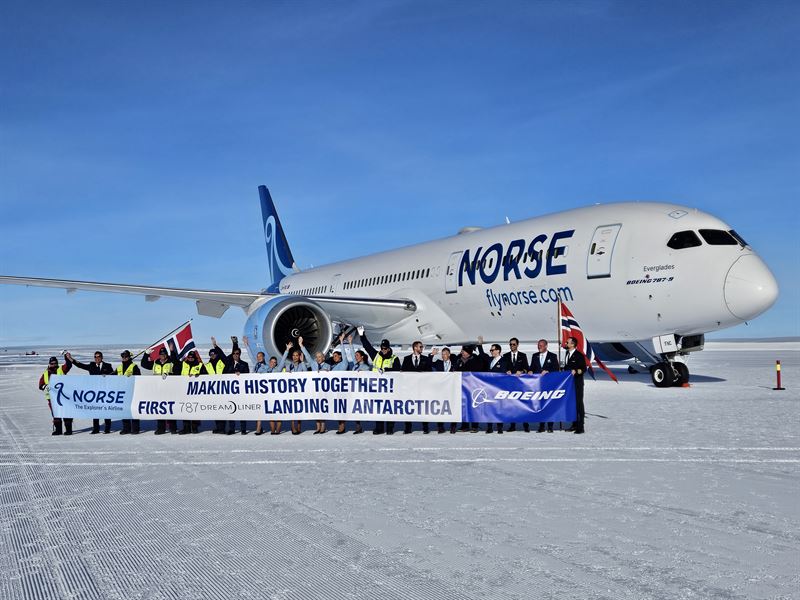Aerospace
The First 787 Dreamliner Lands in Antarctica with Norse Atlantic Airways
Pioneering Polar Exploration: Norse Atlantic Airways’ Boeing 787 Dreamliner Touches Down at Troll Airfield

Norse Atlantic Airways, recognized as The Explorer’s Airline, proudly commemorates a historic milestone in aviation by successfully landing its Boeing 787 Dreamliner, with registration LN-FNC and christened “Everglades,” at Troll Airfield (QAT) in Antarctica. This groundbreaking moment occurred at 02:01 local time on Wednesday, November 15th, 2023.
Flight N0787 carried 45 passengers
In collaboration with the Norwegian Polar Institute and Aircontact, Scandinavia’s premier air brokerage firm, Norse Atlantic Airways spearheaded this pioneering mission to transport essential research equipment and scientists to the remote Troll research station in Queen Maud Land, Antarctica.
Flight N0787 carried 45 passengers, including scientists from the Norwegian Polar Institute and other nations, bound for various research stations in Antarctica. The flight also transported 12 tons of vital research equipment crucial for Antarctic exploration.
Commencing its journey from Oslo on November 13th, the Dreamliner made a stop in Cape Town, South Africa, before embarking on the challenging Antarctic leg.
Departing Cape Town at 23:03 on Wednesday, the aircraft spent over 40 hours in South Africa before accomplishing its historic landing at Troll Airfield.
first 787 Dreamliner to land in Antarctica
Bjørn Tore Larsen, CEO of Norse Atlantic Airways, expressed immense pride and honor in achieving this historic milestone:
“It is a great honor and excitement on behalf of the entire team at Norse that we have achieved together this momentous landing of the first 787 Dreamliner. In the spirit of exploration, we are proud to have a hand in this important and unique mission.
It is a true testament to our highly trained and skilled pilots and crew, and our state-of-the-art Boeing aircraft.”
Given Antarctica’s lack of conventional paved runways, Norse Atlantic Airways executed the landing on a ‘blue ice runway,’ measuring 3,000 meters in length and 60 meters in width, at Troll Airfield.
The Norwegian Polar Institute operates the research station situated in Jutulsessen in Queen Maud Land, approximately 235 kilometers from the coast.
Camilla Brekke, Director of the Norwegian Polar Institute, emphasized the environmental benefits of utilizing large and modern aircraft like the 787 Dreamliner for operations at Troll:
“The most crucial aspect is the environmental gain we can achieve by using large and modern aircraft of this type for Troll. This can help reduce overall emissions and the environmental footprint in Antarctica,” stated Brekke, underscoring that landing such a large aircraft opens up new logistics possibilities at Troll, contributing to strengthening Norwegian research in Antarctica.
Daniel Carey, air broker and spokesperson for Aircontact stressed the importance of involving civil aviation authorities for operational quality and security, securing their approval ahead of the mission.

Aerospace
Boeing Transfers Rocket Stage to NASA, Paving Way for Human Moon Mission

Boeing has achieved a significant milestone by providing NASA with the second core stage of the Space Launch System (SLS) rocket.
This crucial component, crafted at NASA’s Michoud Assembly Facility (MAF), is set to propel the Artemis II crew into lunar orbit, marking humanity’s return to deep space after a 50-year hiatus.
The monumental Boeing-built rocket stage, the largest element of the Artemis II mission, will embark on a journey aboard the Pegasus barge, traveling 900 miles to NASA’s Kennedy Space Center.
Comparison of two legendary aircraft B777x vs B747 aircraft:Click here
Upon arrival, it will be meticulously integrated with other essential Artemis II components, including the upper stage, solid rocket boosters, and NASA’s Orion spacecraft within the iconic Vehicle Assembly Building. This intricate integration process is a vital step toward the eagerly anticipated Artemis II launch, slated for 2025.
“Boeing-built products helped land humankind on the moon in 1969, and we’re proud to continue that legacy through the Artemis generation,” remarked Dave Dutcher, vice president and program manager for Boeing’s SLS program. “Together, with NASA and our industry partners and suppliers, we are building the world’s most capable rocket and paving the way to deep space through America’s rocket factory in New Orleans.”
NASA, Lockheed Martin Reveal X-59 Quiet Supersonic Aircraft:Click here
The delivery of Core Stage 2 marks a significant achievement in the evolution of the SLS rocket. Towering over 200 feet and powered by four RS-25 engines, this core stage, coupled with two solid-fueled booster rockets, will generate a staggering 8.8 million pounds of thrust. This immense power is crucial to launching Artemis II and future missions into the vast expanse of space.
The SLS rocket stands unparalleled in its capability to transport both crew and substantial cargo to the moon and beyond in a single launch. Its extraordinary capacity will facilitate the delivery of human-rated spacecraft, habitats, and scientific missions to destinations including the moon and Mars, ushering in a new era of space exploration.
-

 Travel1 week ago
Travel1 week agoAir India to Expand US Operations with Three New Routes After a Decade
-

 Travel2 weeks ago
Travel2 weeks agoWhy We Should Avoid These Stamps in a Passport
-

 Airlines1 month ago
Airlines1 month agoInvestigations Reveal Fake Chinese Titanium in Boeing and Airbus Jets
-

 Tech4 weeks ago
Tech4 weeks agoChina’s CATL Plans 1,800-Mile Electric Plane Launch by 2027
-

 Airport3 days ago
Airport3 days agoTop 10 Largest Airports in the World by Size
-

 Aerospace4 weeks ago
Aerospace4 weeks agoChina’s Fighter Jets Turn Wings into Autonomous Drones
-

 Airlines4 days ago
Airlines4 days agoAir India Rolls Out A350s for Delhi-New York JFK and Newark Routes
-

 Defence3 weeks ago
Defence3 weeks agoBoeing Enhances Chinook with New Engines and Block II Upgrades at $96 Million







